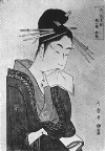
How a Japanese Prostitute
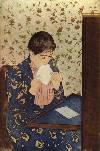
Became an
Image of Bourgeois Virtue.
 |
How a Japanese Prostitute |
 |
Became an |
||
Image of Bourgeois Virtue. |
||
|
By: Poul Genefke-Thye
|
||
| In 1891 the painter Mary Cassatt,
living in Paris, made a colour print. The picture shows a nice young bourgeois
girl about to close the envelope of a just finished letter, she is holding
the envelope to her mouth, licking the flap. She is dressed in a decent
dress not showing anything offensive, which together with the serious look
in her face shows, that she is no careless girl, but the virtuous daughter
of a victorian family.
The model for Mary Cassatt's picture is a 1790ies print by Utamaro, showing a young girl |
sitting in the same position as the European
girl. Utamaros girl is not closing an envelope, but is holding a handkerchief
between her teeth, but the striking likeness in composition, even in details,
makes it clear, that Mary Cassatt not only had seen Utamaro's picture, but
indeed knew it very well., What Mary Cassatt and her
friends and colleagues in 1890ies Paris did not and could not know is, that
biting a handkerchief (or any other textile) in Japanese art indicates a
certain sexual arousement - plainly speaking, Utamaro's young girl is madly
randy! |
||
| |
Actually Utamaro's girl is as far from Mary Cassatt's
Victorian idyll as possible. Utamaro's picture is an advertisment for the
courtesan Hinatsuru, and it signals something like "Hinatsuru will give you
the fuck of your life. Reasonable price" or "For a good lay, call Hinatsuru"
- not very different from advertiments for massage-parlours in some newspapers
today! This could not be said directly in a text or otherwise. Japanese artists were under severe censorship and messages concerning sexual matters had to be given as a discrete hint. This does not mean, that the artists restrained from making really pornographic pictures (shunga), on the contrary, all the artists, great or small, have made shungas, but shungas had to be sold |
secretly from a dark backroom, they were of course
not signed and they lack the censor's stamp - the Kiwame seal. Speaking of secrecy, well - everyone knew what was going on in the backroom, but the pictures were not signed, so who should be prosecuted? Don't mention that everyone easily could recognize the characteristic touch of every artist in the unsigned pictures - when there was no named person to go for, there could be no trial. This way the offical morality was maintained without disturbing a lucrative business. Restrictions nourish double standards in any society including our own, but in this matter the Japanese have evolved their double standards almost to an art. |
|
The Japanese Connection. |
|||
| That this certain school of Japanese art, the
Ukiyo-E woodblock prints, influenced western art in the last decades of
the 19th century, is a fact that very few would dare to argue. But it is
a fact, that most western art critics and historians have succeeded in diminishing,
and very often exiled to footnotes, if mentioned at all. Untill commodore Perry's gunboat-diplomacy in 1853 broke Japan's isolation, Japan and Japanese art and culture was practically unknown in the western world. The Japanese knew somewhat more of Europe, because Dutch merchants were allowed to maintain a limited trade on Japan (from about the year 1600). Before that, the Portuguese had established some trade and a mission, and at the end of the 16th century, the famous Anjin-san was shipwrecked at the coast of Japan, where he later made quite a carreer. At the beginnig of the 17th century the Shogun decided to close the gates for all westerners, with the above mentioned exception for Dutch merchants, who could operate only under |
severe restrictions. Somehow the Shogun had
got the idea, that the christian mission might turn into a fifth column.
Thanks to these extremely limited, but constantly ongoing connections,
small amounts of information travelled both ways. Throughout the whole
period of Ukiyo-E (1600 - 1850), Japanese from time to time got hold of
European prints, artifacts etc. Ukiyo-E artists like Hokusai occasinally
made prints with perspective "in the European manner", and in 1770 Toyoharu
made a print with a motif from Venezia - after a copper-plate print of
a Canaletto painting. About the same time (1770) some Japanese prints
found their way to a Swedish collector, who became the first western collector
of Ukiyo-E. |
||
Ukiyo-E and European painters. |
|||
| In the 1860ies japonism became a hot issue
all over Europe. Over the next decades Japanese prints, lacquers, netsuke,
and other crafts flowed in a constant stream to Europe and the Americas,
where scores of scores of hungry collectors stood ready. Foremost among
the collecters were painters, authors, and leading cultured persons. The influence on arts and crafts was fast and immense. Painting (Impressionism), design of jewelry (Jugend, Art Nouveau), design of furniture (The Vienna School, Functionalism) just to mention the most striking examples. The collectors devoured all this exciting new and exotic, of course unsystematicly and without criticism, which gave way for interpretations. Human beings have a built in aversion to incompleteness, and where exact knowledge is lacking, the empty spaces are filled in with beliefs, presumptions, and interpretation. It is inevitable that these interpretations were more or less inaccurate and often even missed the point completely. |
The French author Edmond de Goncourt wrote a book in 1896, proclaiming Hokusai to be the creator of Ukiyo-E; as a matter of fact Hokusai was one of the last great artists in a long tradition, and his best works mark the peak of this tradition rather than the beginning as Hokusai's life was in the last century of a 250 years long period. More recent authors - like f.i. J. Hillier - have even claimed, that the later works of Hokusai are not Ukiyo-E at all. This in a sense is true, if one interprets "Ukiyo-e" as images from the theater and the entertainment world. In this interpretation it is correct, that Hokusai's landscapes and sketchbooks with images of daily and working life, has nothing to do with Ukiyo-e. However such a narrow interpretation may today be considered at least dubious and might rather be seen as yet another misunderstanding. | ||
Ukiyo. |
|||
| Literally "Ukiyo-E" means "images of the floating
world", "ukiyo" meaning "floating world" and "e" meaning "image" or "picture".
In Buddhist terminology "ukiyo" is the opposite to the sublime harmony of
the soul in the spiritual world. In "ukiyo" life is short, unstable, hard
labour, and worries, thus the translation of the word "ukiyo" is sometimes
also "the unhappy world" or "the miserable world". Like most people, whether from The East or The West, the majority in Japan at the time were not particularly devoted to an ascetic life - as a matter of fact like most people of East Asia they are less religious than westerners. To most of the Japanese population "ukiyo" therefore meant the joys of a secular life, where all the fun is, and where a man (and it was mainly a man's world) could enjoy himself at his pleasure - in more popular terms it is where they roll out the barrel, where the songs and music are happy, and where a man can be sure that any woman is willing to satisfy whatever wishes he may have. |
Japan was at the time (and still is) a country
with somewhat different moral standards than Europe, but one shall not be
lead to believe, that it was a less restricted society with total sexual
freedom; it was different but still restricted. Even in a society with severe
restrictions - and maybe most of all there - a form of security valve is
needed. The Victorian era in Europe is also the time where one could find
the most, the best, and the most distinguished brothels. In Edo (now Tokyo)
one could visit The Yoshiwara District, a part of Edo where all the fun
was, and not only brothels. With a growing hunger for cultural nourishment to a class of wealthy citizens excluded from the aristocracy, it became the centre of all kinds of amusements, especially Kabuki and Bunraku theatres, editors, and booksellers, also selling the Ukiyo-E prints, and of couse all the artists, who found the subjects for their pictures in Yoshiwara. |
||
| |
|||
| Yoshiwara was not only off limits for minors,
it was also off limits for "nice people", which meant the nobility and the
samurai class - the rich merchants, manufacturers, and craftsmen were not
considered to be "nice people", thus they could freely enjoy all the fun
they liked. But don't worry, the aristocracy got their part of the fun.
The aristocrats visited Yoshiwara incognito, under a cover as transparent
as an honest alibi. And they really liked it. One samurai even went as far as to give up the tiresome war business, lay down his swords, instead grabbing a knife and a woodblock to become an Ukiyo-E artist. The broader meaning of Ukiyo-E in every-day Japanese of the time was
pictures, showing the many different aspects of human life, so naturally
human beings must be a main theme in Ukiyo-E. |
man as a theme for his pictures making landscapes
instead. Hokusai together with Constable form the basis on which modern
European landscape painting was build, and Hokusai is in no way less important
than Constable. As mentioned earlier, he is not the founder of Ukiyo-E, but when the decline of Ukiyo-E had started, he founded a new school of woodblock printing, that some - as earlier mentioned - do not regard as Ukiyo-E. Both Hokusai and his followers (Hiroshige and others) made Ukiyo-E as well, most art critics and historians in Europe have therefore not made a sharp distinction, and classifies all Japanese prints from about 1600 to the last decades of the 19th. century as Ukiyo-E. The matter of an exact distinction is of far less importance than the immense influence Japanese art had on European art and artists from about 1860 untill today, an influence that easily can be (and unfortunately often is) underestimated, but hardly can be overestimated. |
||
| The misunderstandings and inaccurate interpretations
of the 19th century were based on a fragmentary material, but some of the
mistakes still live on even today, although people in The West now have
a far better knowledge of Ukiyo-E. The better understanding of foreign cultures
in general as well as a better knowledge of Ukiyo-E in present time, makes
it appropriate to correct some mistakes and to change the general view on
the signification of Ukiyo-E and Japanese artists in the Japanese tradition
as well as in a global context. First of all it must be emphasized, that the |
influence of Japanese art on Western painters is far more than a mere inspiration, as it is casually remarked in western books on art, if mentioned at all. We should get used to the idea, that the Japanese influence is such a vast one, that a major number of tendencies and developments in western art from impressionism to present time art are unthinkable without this influence, and that this influence did not end when the widespread public enthusiasm of Japonism somewhat after the turn of the century diminished, and was carried on only by a smaller group of connoisseurs. | ||
European art in the 19th century. |
|||
| In the 19th century cultural manifestations,
artifacts, etc. of non-European origin were regarded as exotic folklore
or ethnographic curiousities. Although this point of view is no longer valid,
and to some degree has changed, this outdated public attitude still is clinging
to art from foreign civilizations, including the Japanese prints. Some may want to deny this, but one just has to take a look at auctions and other art sales. Japanese prints are still available at moderate prices (lucky for the collectors!) compared to what one has to pay for prints by European artists. Prints by f.i. Toyokuni I or Hokusai are in no way second to f.i. prints by Duerer or etchings by Rembrandt. In the global art history all of these names rank side by side. Undoubtedly it was because of this attitude, that the western artists were so strongly "inspired", that it often looks more like plagiarizing. Van Gogh painted copies of Hiroshige prints, and wrote so. |
But other artists copied parts of Japanese
prints into their paintings without giving away their source. |
||
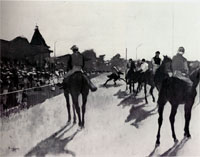
Degas: Longchamps. |
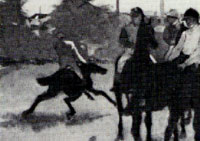
Longchamps (Detail). |
||
| One major influence, in fact the
one that most often is emphasized, and the one that caused one of the most
radical innovations in European art, is the daring way in which Japanese
artists cut the motifs, whereby persons or objects at the edges of the picture
often were brutally amputated. In traditional western rules for composition,
this would cause the picture to be out of balance. It is quite funny, that this important innovation in western art is in fact based on a complete mistake. |
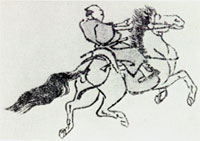
From Hokusai Manga. |
||
|
|||
| Although there is a significant difference
in the perception of perspective, the Japanese artists' conception of
arranging figures within the frames of a picture is not so different from
that of western artists. In Japanese art harmony, balance, movement, drama,
etc. in pictures are expressed very much the same way as in western art. |
Also some of the prints, that came to Europe,
were illustrations from books. An illustration in a Japanese book, covering
two pages, had to be made as two halves, printed on separate sheets. |
||
| |
|||
| Another minor mistake has had quite
a remarkable influence in another area. In most Ukiyo-E prints there is some kanjis and kanas, very often together with kiwame-seal and eventually stamps for month and year. The western artists could not read the text, and quite naturally this gave way for interpretations, some correct and some wrong. Thus the western artists mistook the kiwame for the artists signature, and several - most prominent among these was Toulouse-Lautrec - were inspired to make a signature (or logo) similar to the kiwame (Lautrec's well known HTL inscribed in a circle). Making a decorative signature was not new in Europe - just remember the signature of Albrecht Duerer - the innovation was to put |
calligraphed letters or ligatures in a circle. |
||
Signature of Toulouse-Lautrec. |
|||
| |
|||
| The purpose of this essay and the emphasized examples is not in any way to diminish the reputation of western artists of the 19rh century. On the contrary they deserve to be highly praised for bringing East and West together. And they were indeed brought together, to such a degree, that today we are not aware of the ongoing influence, because the Japanese culture has become a natural part of our cultural roots in art, design, handicraft, and architecture. As Kipling ended his famous (and usually misquoted) poem: |
...But there is neither East nor West Nor border, nor breed, nor birth When two strong men stand face to face Though they came from the ends of the earth. Just replace the "strong men" with "cultures" or "civilizations". |
||